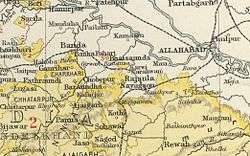Chaube Jagirs
| Chaube Jagirs | |||||
| Jagirs | |||||
| |||||
 | |||||
| History | |||||
| • | Established | 1812 | |||
| • | Accession to the Indian Union | 1948 | |||
| Area | |||||
| • | 1901 | 247 km2 (95 sq mi) | |||
| Population | |||||
| • | 1901 | 20,711 | |||
| Density | 83.9 /km2 (217.2 /sq mi) | ||||
The Chaube Jagirs, also known as 'Kalinjar Chaubes', jagir states were a group of five feudatory states of Central India during the period of the British Raj. They were a British protectorate from 1823 to 1947 and belonged to the Bagelkhand Agency. Their last rulers joined the Indian Union in 1948.
History
Until the 18th century the original lands of the family had been in Dadri, near Nowgong cantonment. Once under the service of Raja Chhatrasal of Panna State the Chaubis reached high positions. The owners of the first four estates were descendants of Ram Kishan, the former governor of Kalinjar under Raja Hirde Sah of Panna.[1]
When Ali Bahadur, the Nawab of Banda invaded Bundelkhand, Ram Kishan seized Kalinjar fort. For ten years he resisted the efforts of the Nawab to take over the fortification.
When British rule was established in India, Kalinjar was ruled by the sons of Ram Kishan. They had been seven brothers, but the eldest, Baldeo, had died and the youngest son Daryau Singh was in command. In 1812 the British government granted them a sanad acknowledging the possession of the territories by Daryau Singh and his brothers.
But Daryau Singh opposed the British and began to disturb the peace, so that on 16 January 1812 Coronel Martindell attacked Kalinjar fort. In the end Daryau had to negotiate surrender under the condition that certain lands would be given to his relatives in exchanges for those he owned. The condition was accepted by the British authorities, but the negotiations were difficult. Separate sanads were issued, including one for Gopal Lai Kayasth, who had been the wakil of the family. In 1817 there were further disagreements.
In 1862 the jagirdars were granted a sanad of adoption. The rule was that when there were no heirs the estate was split between the other members. Initially there were nine principalities but in 1839 two were already extinguished. In 1855 one estate was seized owing to the implication of the ruler in a murder case. Also in 1864 another principality was extinguished and thus only five remained. [2]
The Jagirs were under the Bundelkhand Agency of the Central India Agency until 1896 when they were transferred to the Baghelkhand Agency.[3] In 1931 they were transferred back to the Bundelkhand Agency.[4]
Chaube estates
The estates were:
- Bhaisunda भैसुंदा
- Kamta-Rajaula कामता-राजुला
- Pahra पहरा
- Paldeo पालदेव
- Taraon तरौन
Annexed by the British
Thwo states were confiscated by the British:
- Purwa with 9 villages and an area of 53.18 km² (annexed in 1855)
- Nayagaon with 18 villages and an area of 65.11 km² (annexed in 1864)
See also
References
- ↑ "History of Satna". Satna District Administration. Retrieved 2010-08-18.
- ↑ Columbia-Lippincott Gazetteer p. 1414.
- ↑ Great Britain India Office. The Imperial Gazetteer of India. Oxford: Clarendon Press, 1908
- ↑ Imperial Gazetteer of India